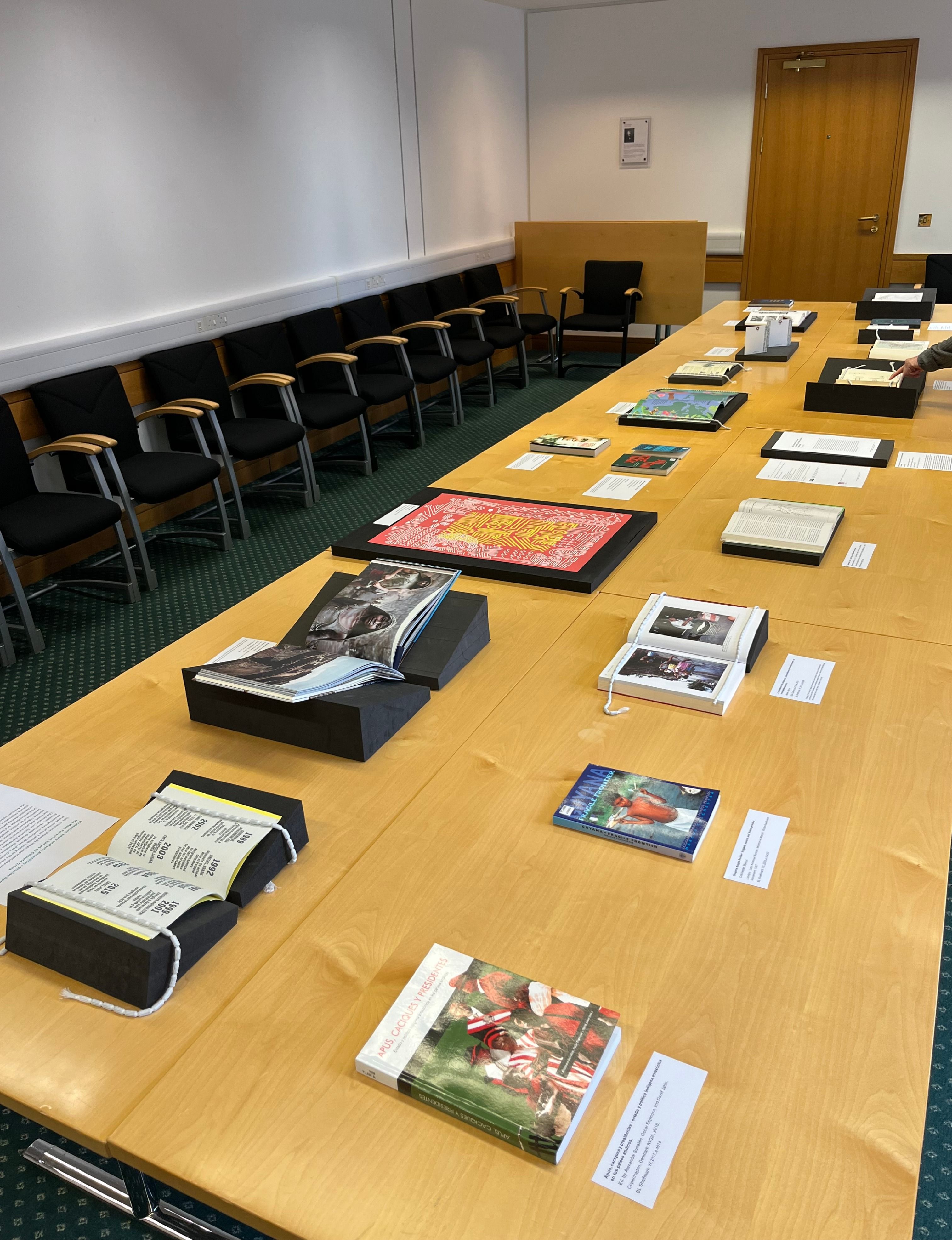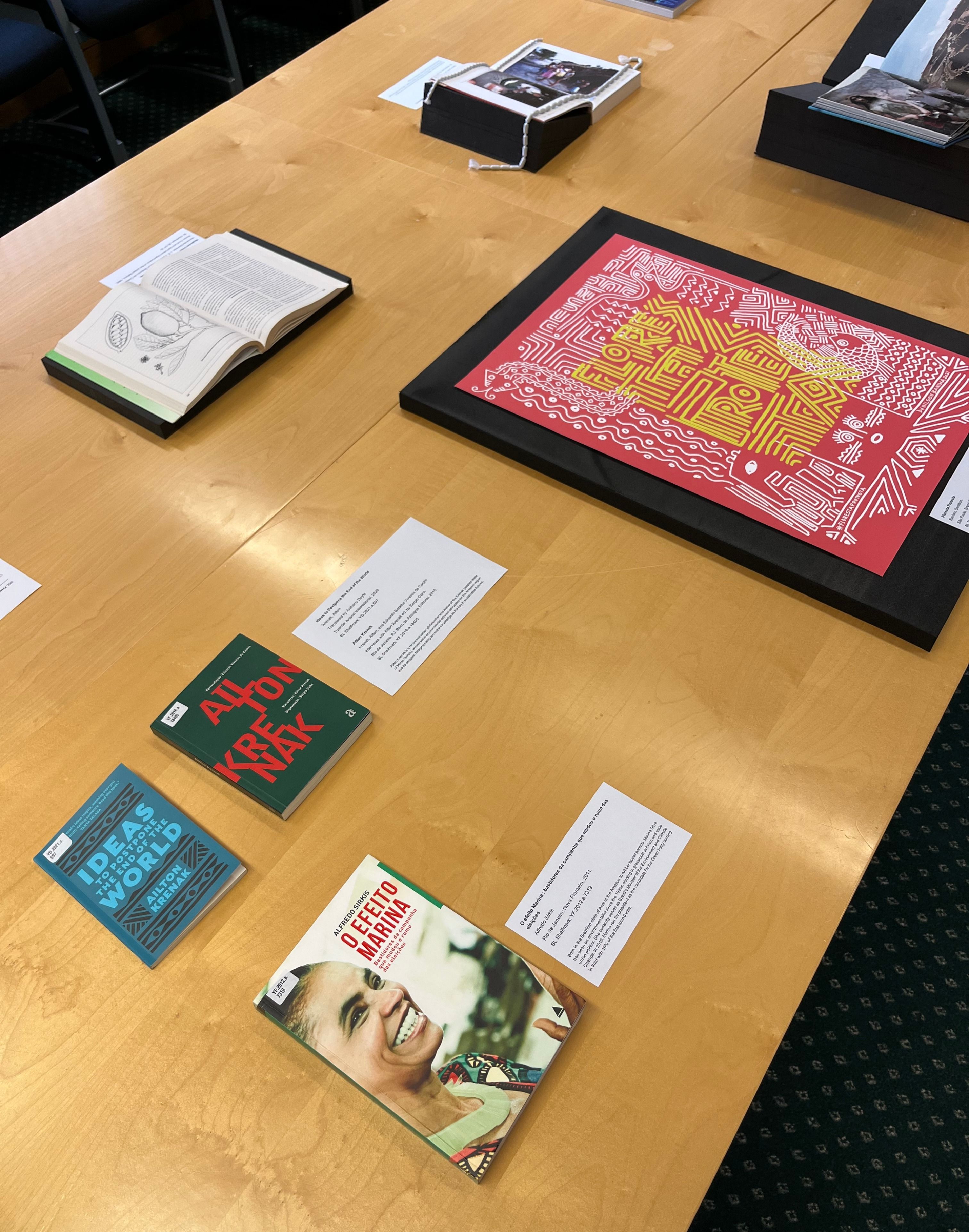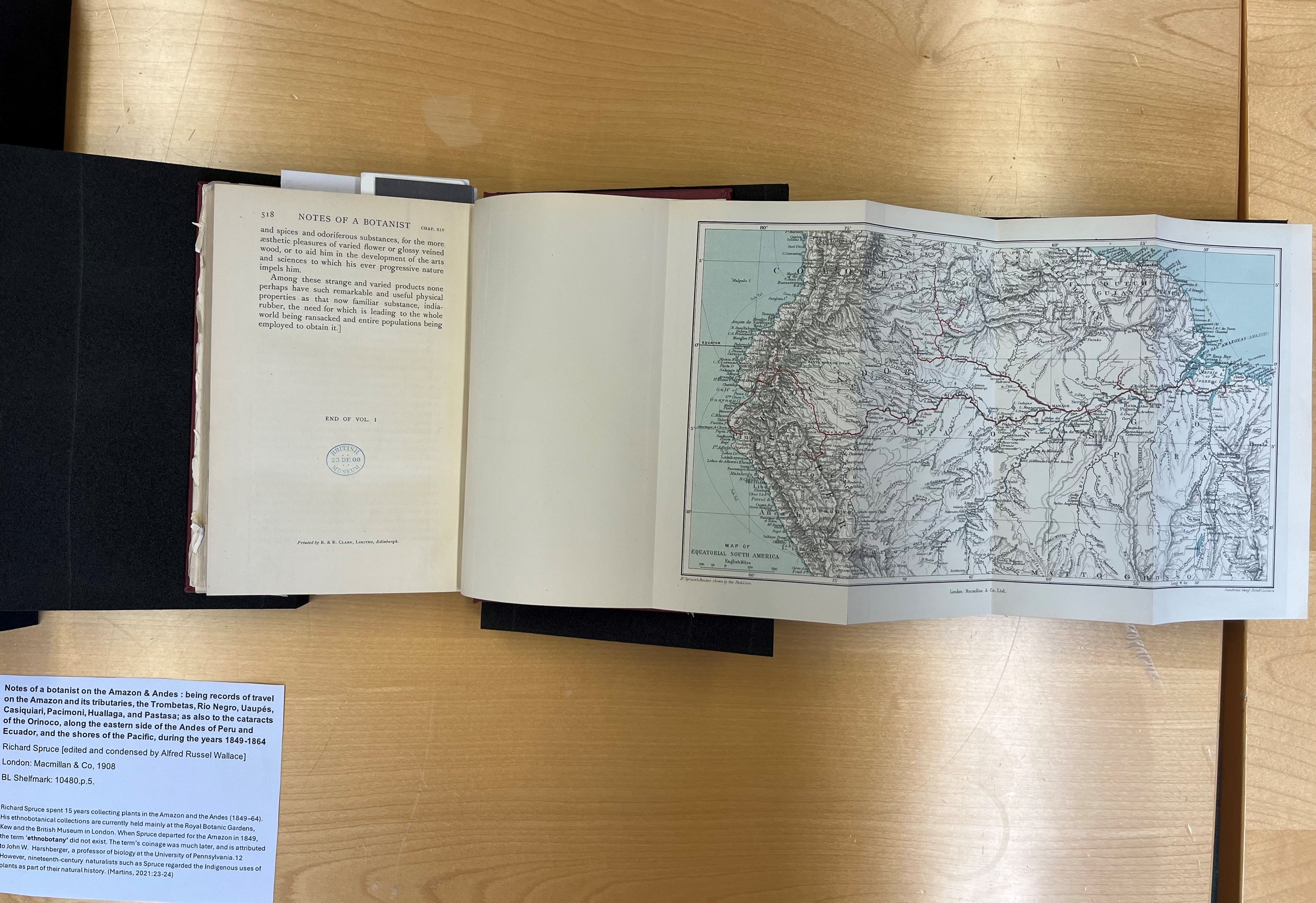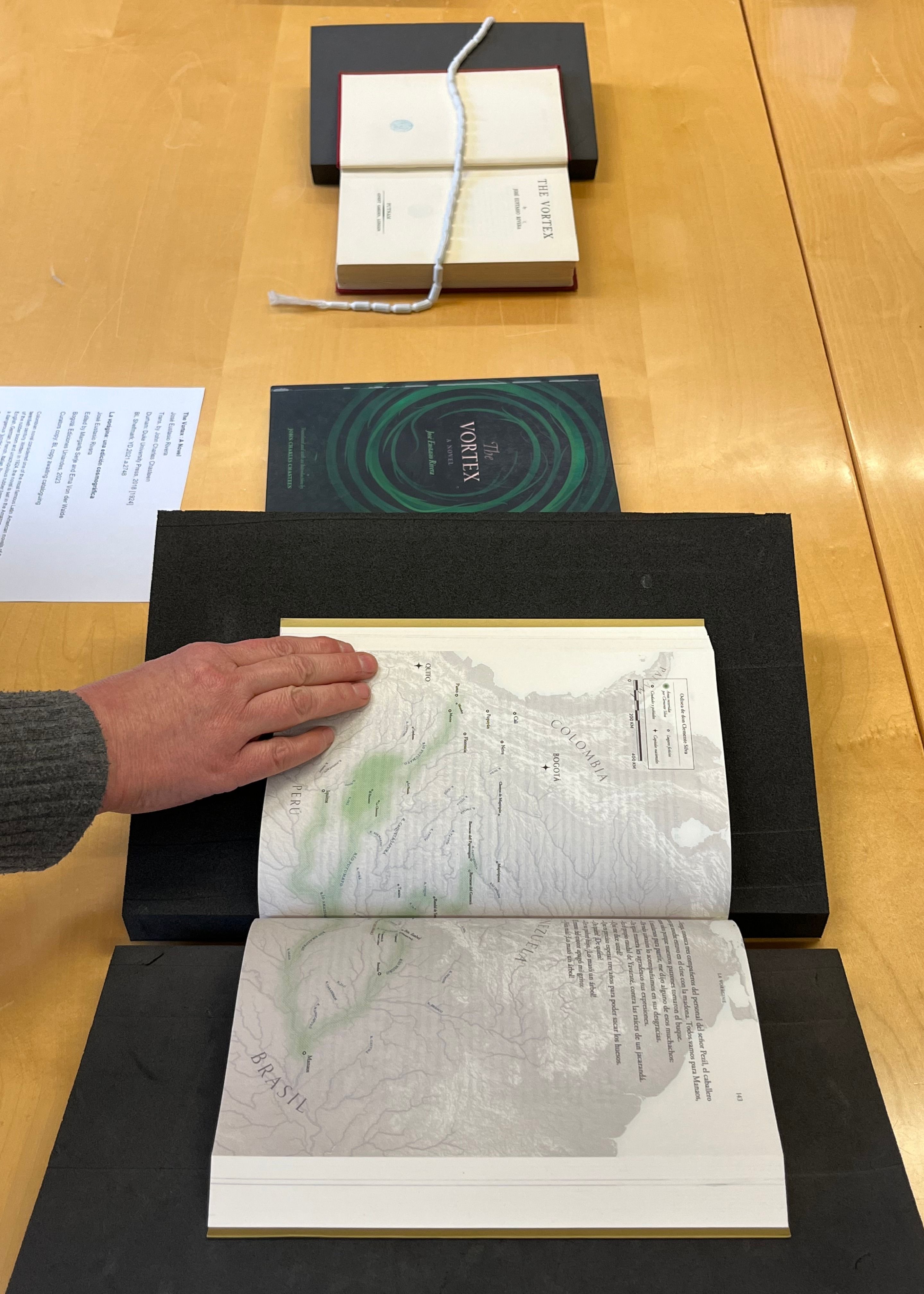Amazonia: Stories from the rain forest in times of climate crisis
As COP30 closes in Brazil, discover items from the Library’s collection which highlight issues of climate change and nature loss in the Amazon.
21 November 2025As COP30 closes in Brazil, discover items from the Library’s collection which highlight issues of climate change and nature loss in the Amazon.
21 November 2025Blog series Knowledge Matters blog
Author Iris Bachmann, Curator for Latin American collections at the Eccles Institute for the Americas and Oceania
Our collection holds many items from and relating to the Amazon region, which spans nine countries (Bolivia, Brazil, Colombia, Ecuador, French Guiana, Guyana, Peru, Suriname and Venezuela). Inspired by COP30 taking place in Brazil earlier this month, you can research and enjoy our collections long after climate negotiators, researchers and activists have left Belém.
The Amazon rain forest is the largest tropical rainforest in the world and plays a crucial role in global biodiversity, climate regulation and carbon storage. It sustains the livelihood of 40 million people and is home to an abundance of local knowledge and languages.

The Amazon region has a long history of peoples living along this enormous waterway and its tributaries, long before European and North American ‘explorers’ and later Latin American elites of emerging nation states tried to map out the territory for trade and extractive industries such as rubber tapping, mining and more recently expanding agrobusiness for soy and beef production to meet consumer demands.
Voices from the Amazon have long taught us to respect the region and its peoples. Philosopher, prolific author and political activist Ailton Krenak’s essay collection Ideas to Postpone the End of the World [BL shelfmark: YD.2016.a.18405] lays out a socio-environmental view foregrounding ancestral knowledge as the key to sustainable futures.

Collection display of books by and about Ailton Krenak and Marina Silva, and a poster with artwork by Denilson Baniwa.
Marina Silva, the current Minister for the Environment and Climate Change in Brazil’s president Lula da Silva’s cabinet and three times runner-up in the presidential elections, is another long-time activist, trade union leader and politician fighting for the preservation of the Amazon rainforest. In O efeito Marina : bastidores da campanha que mudou o rumo das eleições (The Marina Effect: the campaign that changed the course of the elections) her campaign manager Alfredo Sirkis tells the story of her 2010 presidential bid as a candidate for the Green Party [BL Shelfmark: YF.2012.a.7319]. She won an astonishing 19% of the vote in the first round. That is roughly one in five people!
Our collections also hold art and research about art from the region. Sally Price and Richard Price show a collection of Afro-American Arts of the Suriname Rain Forest in their meticulously researched and wonderfully illustrated book [BL Shelfmark: X.421/21955]. It includes photos of traditional architecture build to withstand flooding and to self-regulate climate. The internationally renowned artist and indigenous activist Denilson Baniwa has created a striking poster as part of a recent series inviting artists to respond to the theme Floresta Protesta (Forest Protests) with the double meaning of ‘protests’ as a plural noun or as a verb thus imbuing the rainforest with agency [BL Shelfmark: HS.74/2595(8)].

Sally Price and Richard Price’s book on Afro-American Arts of the Suriname Rain Forest. [BL Shelfmark: X.421/21955].
Closer to home, Yorkshire botanist Richard Spruce spent 15 years collecting plants in the Amazon and the Andes. His Notes of a botanist on the Amazon & Andes: being records of travel on the Amazon and its tributaries, the Trombetas, Rio Negro, Uaupés, Casiquiari, Pacimoni, Huallaga, and Pastasa; as also to the cataracts of the Orinoco, along the eastern side of the Andes of Peru and Ecuador, and the shores of the Pacific, during the years 1849-1864 were edited and condensed by his friend and fellow naturalist Alfred Russel Wallace and published posthumously in 1908 [BL Shelfmark: 10480.p.5.].

Fold-out map of the Amazon region from Spruce’s Notes of a botanist on the Amazon & Andes [BL Shelfmark: 10480.p.5.].
Spruce’s ethnobotanical collections are held mainly at the Royal Botanic Gardens, Kew and the British Museum in London. Luciana Martins (2021:23-24) explains that ‘when Spruce departed for the Amazon in 1849, the term ‘ethnobotany’ did not exist. The term’s coinage was much later, and is attributed to John W Harshberger, a professor of biology at the University of Pennsylvania. However, 19th-century naturalists such as Spruce regarded the Indigenous uses of plants as part of their natural history.
Two decades later, the novel La vorágine (The Vortex) by Colombian writer José Eustasio Rivera was published. Set in the Amazon region during the time of the rubber boom and unscrupulous rubber barons, Rivera’s aim was to denounce the exploitative nature of forced indigenous labour under often inhumane conditions to extract natural latex from rubber trees for the use in waterproofing and pneumatics. The novel was quickly translated into English, German, French, Italian, Portuguese and Russian. We hold editions in Spanish and English including an excellent recent translation by John Charles Chasteen [BL Shelfmark: YD.2021.a.2748].

Serje and Von der Walde’s edition of the novel La vorágine.
The most recent Colombian edition La vorágine: una edición cosmográfica edited by Margarita Serje and Erna Von der Walde brings together texts for the study of the cosmos of the Amazon-Orinoco basin depicted in the novel and its role in the imagination of the Colombian republic and its wider Latin American and international readers [currently awaiting cataloguing].
The Irish human rights activist avant la lettre Roger David Casement was attached as a consular representative to a commission investigating reports about an enslaved workforce in the Putumayo region collecting rubber for the Peruvian Amazon Company (PAC), which had been registered in Britain in 1907 and had a British board of directors and numerous stockholders. This became known as the Putumayo genocide. Peruvian writer and nobel laureate Mario Vargas Llosa fictionalised Casement’s mission in his 2010 novel El sueño del celta translated into English as The Dream of the Celt by Edith Grossmann in 2012 [BL shelfmark: H.2015/.6980].

Rozos’ accordion-folded photobook.

Illustration by Paola Rozo
I would like to conclude this blog with reflections on a photobook by Bolivian artist and visual facilitator Paola Rozo acquired at the London Spanish Book Fair. As she explained to me ‘the first three photographs (mainly white and blue) were taken in 2013, in Rurrenabaque, a town in the Beni department of Bolivia, north of the capital La Paz. Rurrenabaque lies on the southern edge of the Amazon rainforest and serves as a gateway to the region. The fourth photo (predominantly grey) was taken in 2021 in Bournemouth, near the beach. The idea behind this photobook is to contrast the beautiful wooden textures as a result of a tacit collaboration between people and the surrounding environment (e.g. sun, plants, humidity, insects, moss, time, etc) in both Amazonia and the UK’. This tacit collaboration speaks to the idea encapsulated in the illustration kindly created for this blog by Paola: Amazonía VIVA | Humanidad Segura which means: IF Amazonia remains alive, THEN humanity is safe.

This blog is part of our main British Library series, Knowledge Matters. Join us to look at the strategic bigger picture at the UK national library and get behind the scenes on a wide range of activities, projects and programmes. It features contributions by experts and managers from across the Library’s departments and locations.

You can access millions of collection items for free. Including books, newspapers, maps, sound recordings, photographs, patents and stamps.